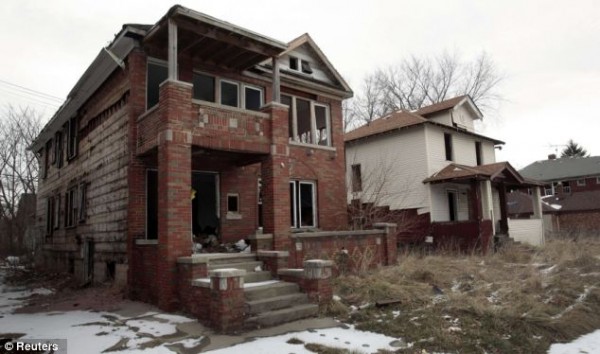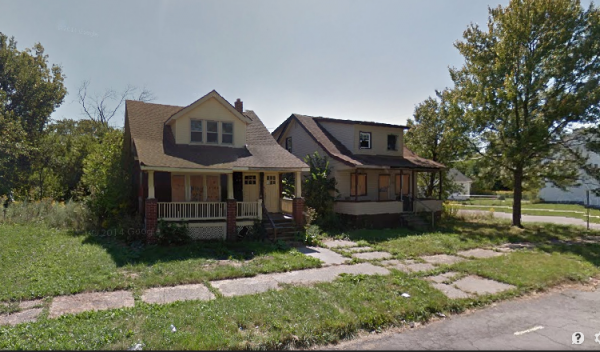
Is Detroit the nations largest ongoing crime scene?
Detroit: The Crime Scene
The Dodge pickup truck rolled west on Eight Mile Road, unofficially the line of demarcation separating the former East Detroit, now East Pointe, from the incorporated war zone know as Detroit, Michigan. At Gratiot Avenue we had to make a “Michigan left turn”, that is we turned right onto Gratiot then merged to the left and made a legal U-turn through the dividing median.
With the skyline of downtown Detroit on the southern horizon, the four-door silver Dodge eased cautiously into occupied territory. Only half-joking I asked if they had set up check points yet to restrict access in and out of the city. Gratiot Avenue is the main surface road leading people from downtown Detroit to the suburbs of East Point, Roseville, and Clinton Township.
From a practical standpoint, the farther north of Eight Mile Road you travel the safer you are or, at the least, less likely be carjacked or murdered for the contents of your pockets. We were heading in the opposite direction that good sense would dictate. I had to see with my own eyes what had become of the neighborhood I knew from elementary age to my early high school years.
It was readily apparent that few buildings from my youth remained or remained recognizable. Flanking the major thoroughfare were a combination of boarded up store fronts, check-cashing shops, fast food restaurants, “weave” and “hair extension” emporiums and liquor stores or “party shops” as we grew up calling them. Most every building was adorned with some type of spray-painted gang “tag.”
As a precaution I had slipped a 9mm pistol into my right jacket pocket so it could be more easily accessed from behind the wheel. Another pistol was secured in a holster over my right hip. It was January in Michigan and my holstered pistol was covered by an over-shirt and fleece jacket. Also, I was belted in behind the steering wheel. A pocket gun seemed a prudent choice.

A pocket gun seemed a wise choice.
At the Seven Mile and Gratiot intersection I noted with disappointment that the Montgomery Ward store I had once frequented was long gone. In its place stood a chain burger joint surrounded by a generic looking strip mall. Along the street the inhabitants of what can only be generously referred to as a city ambled along somberly. Most peered out from under faux fur lined hooded jackets.
I spotted the street sign first of all passengers in the truck. “Parkgrove” was printed in white reflective letters on a green background. For a brief moment it occurred to me how fortunate it was that road signs had no “street value”, else they would all have been stolen long ago. Easing the truck to the right I started down an avenue that had seemed much longer in the memories of my youth.
When my family moved into the Parkgrove house during the summer of 1978 the home had already been in the family for forty years. My maternal great-grand parents had moved into the house after it was built in 1938. My mother had lived on the second floor for a short while with her parents when they were a young couple and she was just a little girl.
The two story brick house was where my maternal grandmother resided with her parents whilst she awaited the return of her love from Naval duty in the Pacific during WWII. Pinned up over his bunk on the heavy cruiser USS Helena, my grandfather had a black and white photo of his lovely young fiancé sitting legs crossed on the brick and concrete stoop of the house on Parkgrove.
On this day, it had been thirty plus years since my family left the big old house in Detroit and moved to Ohio where my mother’s relatives had settled. Having family in the greater Detroit area, I had returned to visit occasionally during previous decades, but it had been nearly thirteen years since I had entered the city.
Slowing the truck to a crawl, I peered out the driver’s side window at the houses. Most every dwelling was abandoned or appeared to be so. The weather had warmed just enough to melt much of the Michigan snow and debris could be seen piled up between the houses and in the yards. Soon the moment arrived when I would realize that a part of my childhood was officially dead and subject now only to fading memory and old snapshots in family albums.
The house on Parkgrove was gone. In its place was an empty lot surrounded by a white wooden privacy fence that seemed to belong to the brick house on the left. The upstairs window that I had broken with a baseball at age 12 was no more. The sturdy porch with its brick and mortar walls, where I had sat listening to the thunder and watched the lightning of spring storms, was now accessible only in the recesses of my mind. The small concrete fish pond that my great-grandfather had built in the backyard, and my family had stocked with goldfish and a painted turtle named “Fred”, was buried and forgotten.
Scanning the area for potential threats, I could see that perhaps three or four of the twenty plus houses on the block appeared to be lived in. The rest were either burned hulks, empty shells with all of the windows smashed out and doors removed or they had mercifully been boarded up with nondescript plywood. About one in four or five lots were empty as the houses had simply been demolished and not replaced.
The entire scene seemed a strange fiction. It was akin to some post-Apocalyptic landscape created for a movie depicting the aftermath of a worldwide plague or nuclear holocaust. But this was not fiction; it was modern day Detroit, Michigan, once a thriving engine of American industry now a hollow shell of a its former self, a corpse whose flesh had rotted to the point where the bones had begun to show.
To return to the relative safety of Dearborn, the sleeper cells have not yet been activated, I took I-94, the highway that bisects the Motor City. Along the edges of the Interstate, stood the crumbling ruins of once proud companies, multistory brick buildings adorned from top to bottom with gang-tagging, spray-painted in multiple colors on their decaying surfaces. To see an unbroken window was rare. A two story house stood out amongst the others around it as it had bold pink foam insulation nailed to the outside. The thought that someone was putting money into the renovation of a home there seemed all too bizarre.
Turning on the television to listen to the local Detroit news, we were greeted by a solemn looking anchor who reported that the body of a woman was dumped on a street in Dearborn Heights during the night. In a separate incident, a 20 year old male was shot to death in the backyard of a residential neighborhood in Detroit sometime around 1 a.m. according to police sources. Suspects for both murders were being sought and the public was asked to come forward with any information they might have. Finally, a man was shot outside of a local liquor store but expected to survive his wounds. Suspects were still at large. This was a single news report of one night’s activities. It struck me that the entire city could be described as a massive, ongoing crime scene.
Peering out the window of a comfortable suburban bungalow while watching the light snow fall on a gray afternoon a question begged to be answered. Can Detroit be saved? With that, the philosophical question could be put forth; does Detroit truly want to be saved from its current state? And does it deserve to be?

The body has decayed to the point the bones are showing.
Complicity to Murder
Certainly Detroit, Michigan did not fall into such a state of decay overnight. The steady decline has been taking place for decades. I used to joke that my family “escaped” from Detroit in 1983 and as a practical matter, that jest was not far from the mark.
While a large share of the blame can be deposited at the feet of the city fathers starting the in 1970’s, there are hundreds of thousands who could be indicted for complicity in the murder of a city that was once known as an arsenal of democracy in the 1940’s and a thriving metropolis of industry that rivaled others worldwide.
During WWII, manufacturing plants in and around Detroit tirelessly produced tanks, trucks, and aircraft in support of the war effort. My grandmother, then a teen, had been one of thousands of young ladies working as riveters in an aircraft factory during the war.
In the post war years of the 1950’s and 60’s Detroiters set to work producing automobiles for a nation hungry to hit the open road and explore the countryside along the thousands of miles of Eisenhower’s Interstate Highway project. These men and women answered the call and Fords, Chevys, and Chryslers rolled off the assembly lines. It was safe to say that every nuclear family in Detroit was either employed by the auto industry or supported it in some form or fashion. My paternal grandfather retired from Cadillac when I was in diapers and my uncles and aunts worked for Holley Carburetor and Chrysler.
Jim Hoffa’s Teamsters, the UAW, the AFL-CIO and others of their ilk put the screws to the Big Three automakers and the supporting manufacturers. Wildcat strikes and threats of strikes kept the corporations in line. Wages rose and so did the contributions to the union coffers. As long as profits were high and the national economy strong, Chrysler, Ford and GM could afford to pay union extortion; then came the Carter Administration.
Combined with the national depression following the Vietnam War, James Earl Carter set about destroying the American economy. A national “malaise” enveloped the nation. Gasoline prices surpassed $1 per gallon for the first time in history. Both phantom and genuine gas shortages caused the American people to panic. Cross country road trips were set aside. Luxurious new car purchases seemed out of reach to most. People we ordering Volkswagon diesel cars and happy to get on a two year waiting list. Diesel fuel was then much less expensive than gasoline.
Union workers with little fear of losing their jobs to due to poor performance became sloppy and haphazard. Quality suffered dramatically. Jokes about never buying a car made on Monday or Friday were prevalent. Foreign cars began to rival and surpass American cars for quality and economy.
The river of new car sales slowed to a trickle. Lay-offs came in waves. Inner-city crime was on the rise in the Motor City and slowly but surely, Detroit families turned their eyes to the suburbs. Many Detroiters with marketable skills began to look elsewhere, including other states.
It was not just the people who were looking elsewhere. Manufacturers began to search for friendlier climes. The one-two punch of union extortion and confiscatory taxation forced businesses to move away or close their doors for good.
By the late 1980’s Detroit was hemorrhaging jobs to other cities and states. Despite this fact, the people kept right on electing mayors and other public officials who served up more of the same. A string of mayor’s each more corrupt and criminal than the next continued to mortgage the city’s future to the next generation.
The introduction of “crack” cocaine to Detroit in the 1990’s set the slow and steady decay into high gear. Productive citizens with options took their families and fled like refugees ahead of an invading army. Detroit neighborhoods burned in a rash of arson. Murder rates began to soar to heretofore unheard levels.
Millions upon millions of dollars were pumped into the downtown riverfront area to create the illusion of prosperity. “Greektown” was promoted as a tourist destination and the city police created a type of safe-zone, or “green Zone” if you will, around the tourism district. The Detroit Tigers got a brand new stadium that could be shown on national TV as a demonstration of the “re-birth” of the Motor City.
Despite the riverfront safety zone and shiny new stadium, the greater Detroit area remains in a state of ruin. Nearly half of the buildings in the city are abandoned. Thousands of acres of once prime industrial land sit empty and uninhabited, save the rats and feral dogs.
Predatory gangs prowl the streets of the city day and night. Those foolish enough to be caught unaware are pounced upon, beaten or killed for their car of the contents of their pockets. Children are killed weekly during drive-by shootings and gang-related turf wars.
The few inhabitants of Detroit not actively involved with drug gangs or customers of the same are prisoners in their own city. They sleep behind barred windows and triple-locked doors. They fear attack going to and from work and dare not go out late at night. This situation inspired the Detroit Police Chief James Craig to advise the good people to arm themselves and fight back as the police department simply cannot keep them safe.
Cautionary Tale
“But I don’t live in Detroit” you might be thinking, “so I don’t care.” Care you should. Detroit is a cautionary tale for the entire United States of America. A once proud and powerful city laid low by corruption, greed, and apathy. Is it a coincidence that the Democrat Party took the Mayor’s office in 1962 and has overseen the steady and continuous decline for fifty plus years? You might query Kwame Kilpatrick, Mayor of Detroit from 2002 to 2008 now serving 28 years in Federal Prison for multiple corruption charges.
The current Mayor, Mike Duggan, engaged in a successful bid for the top seat in the Motor City after losing the Democratic primary election. Duggan was elected as a write-in candidate; that fact, in addition to the hiring of James Craig at the city’s top cop, would seem to indicate that the few remaining productive citizens of Detroit are seeking salvation.
Can Detroit be saved? At this point the Motown would seem to have Stage IV cancer. Nothing short of invasive surgery, aggressive chemotherapy, and heavy prayer can hope to save it. Is there anything left worth saving? Time will tell. One thing would seem painfully obvious. Unless Detroit can secure stouthearted leaders who are able to find resolute and dedicated souls who are willing to shed business as usual and fight corruption and crime on all fronts, I fear the city of my birth is doomed.
Paul Markel 2015
